New Dawn of the Giants

We live in an interesting time when the number of active projects of super-heavy launch vehicles has already exceeded the number of fingers on one hand. State space agencies and private companies announce their plans for the creation of super-heavy rockets, and although most will have to fly in the 2020s, we have chances to see the first launch of one of them next year. But in the history of astronautics, super-heavy rockets repeatedly lost, and these projects were closed. What awaits them now?
Formal definition
Nowadays, a super-heavy rocket is considered to be capable of launching more than 50 tons into near-earth orbit.
All for the moon
The first super-heavy rockets had one goal - the Moon, and were developed for the American and Soviet lunar programs. The use of similar technical solutions with a separate lunar module and docking in the lunar orbit led to the fact that the rockets turned out to be quite similar.
')
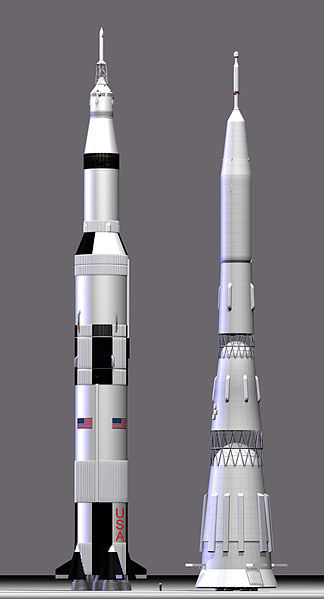
"Saturn V" and "H-1"
With a diameter greater than 10 m (“Saturn V” 10.1 “N-1” - a cone with a base of 16.9 m) and a starting weight of three thousand tons (“Saturn V” 2,970 tons, “N-1” 2,735 tons) These missiles were huge so much that even now there are people who doubt their real existence.

In the US, they were able to develop oxygen-hydrogen engines and put them on the second and third stages, so the capacity of the Saturn V was about one and a half times larger than that of the N-1 (~ 140 tons against ~ 90). “Saturn V” was so specialized for lunar missions that it’s even difficult to say how many tons he would have put into low near-earth orbit - the third stage was activated twice, first deducing itself and the payload to a low orbit, and then turned on a second time and accelerated "Apollo" to the moon. Without the third stage, the carrying capacity of the Saturn V turned out to be more modest - the weight of the Skylab station put into low near-earth orbit is approximately 77 tons.

"N-1" in the lunar version was already a five-speed rocket. Three stages brought to Earth orbit about 90 tons. The fourth stage was spent on dispersal of about 40 tons to the Moon, and the fifth slowed down ~ 15 tons of orbital and landing ships in the Moon's orbit.
Nothing for the Earth?

The program of super heavy rocket "N-1" was closed in 1974 after four unsuccessful launches. In addition to technical problems, the politician who became the chief designer of V.P. Glushko could not relate well to the rocket, for which he refused to do engines for ten years earlier. S.P. Korolev was forced to turn to Nikolai Kuznetsov, and his relations with Glushko were spoiled forever. On the question of whether it was possible to successfully use the H-1 missile, find the political will to do this, it is now impossible to answer. On the one hand, the NK-33 engines were refined and tested according to the documents quite successfully, on the other hand, the Antares accident of 2014, on which NK-33 from the lunar reserves were stored, was carried out according to the N-1 accident scenario. you can’t tell whether the engine’s construction is unsuccessful, or they cannot be stored for long. But if the engines were not to blame, and in the 70s the USSR would have the political will to give an asymmetrical answer to the American victory in the lunar race, the “H-1” could launch heavy orbital stations, scientific or interplanetary vehicles.

“Saturn V” policy killed at the pinnacle of success. The idea to launch an orbiting station closed the Apollo-20, and by 71 the same fate befell -19 and -18. The budget cuts were so dramatic, the missiles and ships already built had nothing to launch, and instead of space they went to museums. Against the backdrop of the idea of a reusable shuttle, which looked so good on paper, the Saturn V probably did not have a real chance to survive. "Saturn V" made 13 flights - two test, ten with people to the Moon and one with the orbital station to a low near-earth orbit.
Oh, one more time

The conventional second generation of super-heavy rockets revolves around the idea of reusability. And if the Space Shuttle can put only 27 tons of payload into orbit, the orbiter with wings, thermal protection and seven astronauts with food, water and oxygen weighs under a hundred tons - the maximum mass of the shuttle and payload was 122.5 tons. It would be logical to create a one-time cargo module for extra heavy loads, and so the project Shuttle-C was born. Instead of a large and heavy shuttle, a smaller and much lighter unmanned module would be installed at the start, which, however, would allow to bring around hundreds of tons.
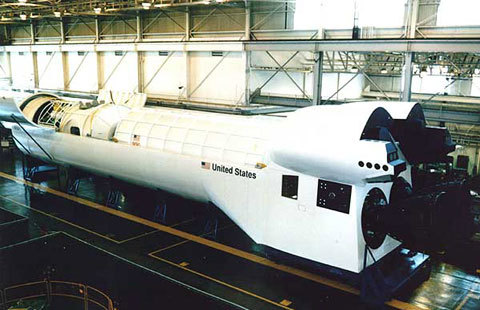
The project was going well, they even managed to make a full-size mock-up, but then in 1986 the Challenger crashed. After it, the ambitions of the shuttle program were greatly shrunken - the shuttle launch program from the Vanderberg cosmodrome to the polar orbit was closed, some technical improvements were canceled. The Shuttle-C project managed to survive this, and in the 90s, NASA planned to launch 80-ton modules of the Martian ship on it. But then a Colombian disaster struck, and the Space Shuttle program lost any future. The fact that the planned flights were carried out for another eight years no longer mattered. In principle, the Shuttle-C had non-zero chances to become a replacement for manned spacecraft - the unmanned version could be made at the same factories and did not bear the risks of crew death, but it seems that politicians did not want to get involved with anything that had the name “shuttle”.
In the USSR, they again made a more versatile option - the Energia launch vehicle could, without any modifications, carry a one-time payload or a reusable Buran ship.
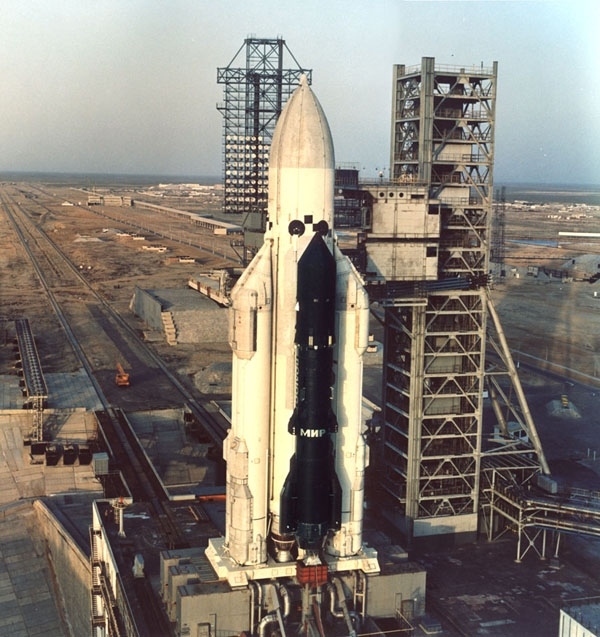

But here it is impossible to find chances for an alternative development of events. “Energy” and many other complex technical systems covered the wreckage of the Soviet Union, and two successful flights (one with the Polyus platform, the other with the Buran unmanned aircraft) could not continue, and the hardware created for the program did not even go to museums. - Two assembled rockets at Baikonur suddenly turned out to be the property of Kazakhstan, stood for nine years in a hangar and died ingloriously under a collapsed roof.
Zombies will not be
Is it possible to revive the "Saturn V" or "Energy"? If you think a little, the answer becomes clear. People who designed and made these rockets, and knew some technical features, retired or in the grave. Documentation is mostly lost. Equipment plants, which made hundreds of thousands of different components, broke down or hopelessly outdated and thrown away. And the factories themselves are no longer those that were in the 60s or 80s. We, as humanity, on both sides of the ocean, have not forgotten how to make rockets, but if we want to build a super-heavy launch vehicle, even using the best practices of old projects, something new will happen anyway. We have learned to make other materials, even more advanced electronics, and blindly repeating old solutions is stupid, much can be improved. Therefore, some new super-heavy rockets can use upgraded old components, and in a sense will be descendants of a glorious past.
Curve take out
When it became clear after the Columbia disaster that the Space Shuttle project would be closed, the question arose of what to do with the plants, companies and workers who were involved in the project. Plus, the idea of returning to the moon with the ultimate goal - an expedition to Mars. And for all this, a super-heavy rocket is desirable in order not to launch many times a part of the ship and not dock them in Earth orbit. Thus was born the project Constellation ("Constellation") with the 188-ton super-heavy Ares V rocket into low orbit.
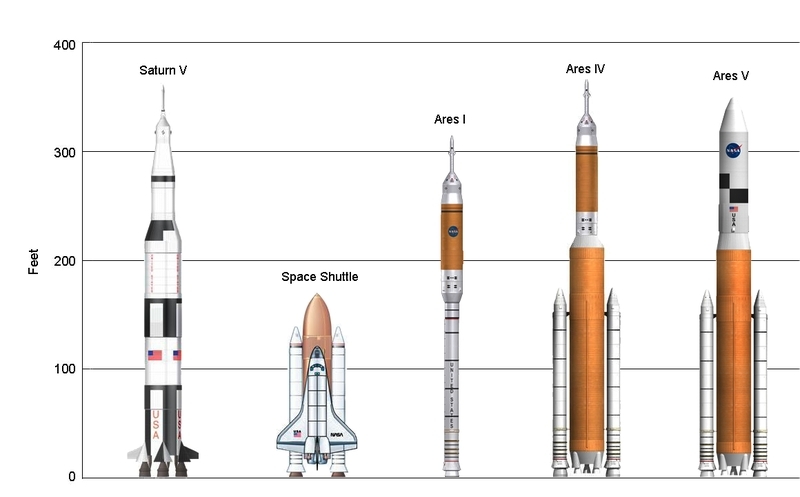
In the layout of the rocket, you can easily recognize the legacy of the Space Shuttle - side solid-fuel boosters and the characteristic heat-shielding coating of the first-stage tank of orange color. The first stage had to have RS-25 engines from the shuttle, and the second stage was an updated version of the engines of the lunar program J-2 - J-2X.
The program was moving quite successfully, but after the regular elections of the Republican Bush Democrat Obama replaced. And the program "Constellation" was closed in 2009. But the problem of closing factories and losses of companies has not gone away, so the project was actually opened back in 2010, but under a different name. Now it has become known as the Space Launch System - Space Launch System, SLS. The pictures for the conspiracy even repainted the tank of the first stage in white.
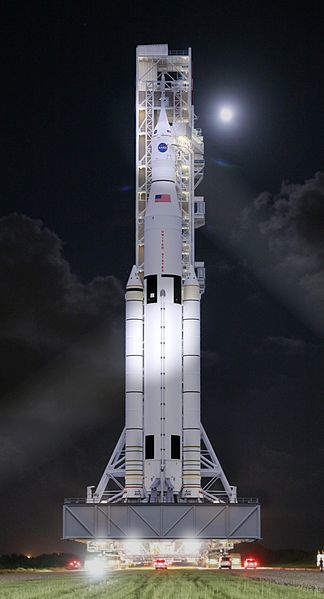
But as time went on, the program developed, and the conspiracy could not be respected - the tank in the pictures was repainted back.

In general, the SLS is very similar to the Ares V - the same solid fuel boosters on the sides, the same RS-25 engines from the shuttle in the first stage. However, on the upper steps, the J-2X engine was replaced with RL-10 from the Centaur upper stage.
On the one hand, SLS is in one of the most ready states from all projects. Work is underway, money is allocated, the next launch is scheduled for November 2018, and even if he, as is usually the case with technology, will move forward a year or two, he may still be the first among competitors. On the other hand, there is a new election in the US, and it is completely unknown how the new president will develop cosmonautics. In addition, only the political motivation of the project can negatively affect the SLS - this rocket cannot be reduced and used for commercial launches; it is suitable only for large and expensive missions to an asteroid or the Moon. And the second launch is expected only in 2022, and the greater the distance between the launches, the more additional problems and risks that the next news will adversely affect the program.
Two write, three in mind
The private company SpaceX already has two projects of super-heavy rocket, and, based on obvious engineering considerations, there may be three of them altogether. The most ready is the Falcon Heavy project. Collected from the first three stages of the Falcon 9 booster should be able to bring, according to calculations of SpaceX, 54 tons into a low orbit.

The great advantage of Falcon Heavy is that it contains a minimum of new parts - the first steps of the Falcon 9, even with modifications, will not differ much from the standard ones that are already flying. The second advantage is that commercial orders have already been announced for Falcon Heavy launches. However, there is a very curious situation here - the super-heavy launch vehicle, which, as they say in SpaceX, will be able to put 22 tons into a geotransfer orbit, contracted for quite ordinary satellites, according to open information, tons by 6, i.e. large underload. The economic benefit of such a launch is a question that can only be answered in SpaceX, but they have not yet wanted to do it.
But the main problem with Falcon Heavy can be called permanent delays, initially its first launch was planned for 2013. There was some hope for a first launch in 2016, but the recent Falcon 9 crash put an end to these plans. It remains only to hope that the launch will not move further, at 2018.
But Musk did not stop at one project of a fully realizable super-heavy rocket. At the recent international astronautics congress, he announced a completely monstrous project of a Martian launch vehicle for 550 tons of payload in a one-off version and 300 tons in a reusable one.

The feasibility of such a project is beyond the current capabilities of Mask - this is too expensive for him and has no real scenarios for commercial use (cargo delivery by missiles is the dreams of pioneers of rocket production, which cannot be combined with logistics economics). But, at the same time, SpaceX recently successfully tested a new methane Raptor engine for three hundred tons of thrust. Although it cannot simply be put on the Falcon 9 instead of the oxygen-kerosene Merlin - other components dictate other tank sizes, and even a rocket with a diameter of 3.7 meters gets a bad 2-meter motor. And here a very rational variant is put in for the Mask - with four engines in the first stage and a diameter of, say, 4.5 meters, you get an excellent launch vehicle with a launch weight of around 1000 tons and a payload of about 30-40 tons into a low orbit. The rocket of three such units will output 70-100 tons, and of the five - in the region of 150-200 tons. All figures are given very roughly, because there are a lot of unknowns, but the resulting parameters are impressive. You can make great money on a monoblock by launching any satellites into a geostationary orbit, and heavier options are suitable for Mask's ambitions or contracts with NASA. But for some reason, Musk, instead of a realistic rocket, preferred to announce an impressive, but unrealistic one .
A dark horse
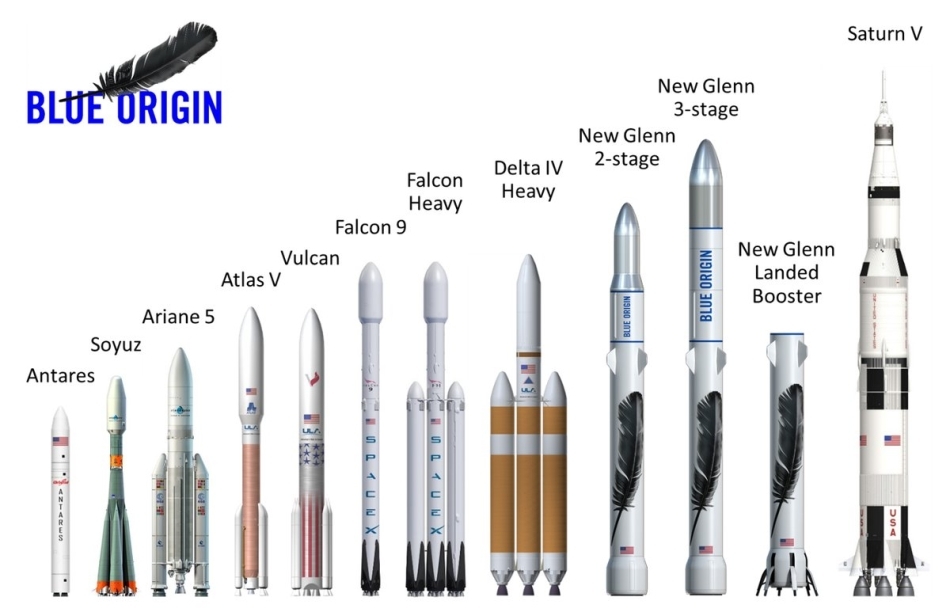
Another private company, Blue Origin, which is successfully developing a rocket and ship for suborbital tourism, was also surprised by announcing the development of the New Glenn super-heavy launch vehicle. Its official capacity has not yet been announced, so you have to guess. With a diameter of 7 meters and the engines of the first stage of 1700 tons, such a launch vehicle can put into low orbit in the region of 100 tons of cargo. The main question is why and why Bezos chose such a large rocket, because it is not clear how he will earn it.
Aleet east

Another dark horse is China. It is known that work is under way on a manned lunar program, and, accordingly, they will need an extra heavy rocket. Its working title is known as the “Great March 9”, the first flight is expected in the 2020s, and the payload should be about 130 tons. To make such a launch vehicle for China, which is already rather the first economy in the world, is in principle possible, it’s a question of political will.
Native penates

Work on the creation of a super-heavy launch vehicle is underway in our country too. From the "Angara" super heavy rocket will not work in any way - the size of the modules is too small. Therefore, a possible lunar program would require at least 4 starts. This is not very effective, so the design of the launch vehicle on heavier universal modules has been hanging in the air for a long time. Moreover, the technologies of the most powerful liquid-propellant rocket engine RD-170 are quite alive in the RD-171 for the Zenit. For the last twenty-five years, the life of Zenit has been poisoned by political problems, and it is most likely over. But rockets of a similar dimension, now called Phoenix and Sunkar, look very interesting. One block of tons per 17, a three-block variant of tons for 40 and a five-block variant with a large hydrogen stage of tons per 100 will in principle make it possible to realize a flight to the Moon with one launch of an extra heavy variant.
What for?
Do you really need extra heavy rockets? They have one unique advantage - no need to assemble a ship to the Moon or Mars with a large number of launches. But historically, all the super-heavy launch vehicles lost, and their projects were closed. Why - easy to understand. If you have a mining truck, then of course you can transport hundreds of tons of land in one trip, but you will not be comfortable driving it to work every day. It will not be possible to earn money on a super-heavy rocket - satellites in geostationary orbit, although they are growing, they do not do it quickly.

Yes, you say, if an extra-heavy rocket appears, then we will be able to launch huge satellites tens of tons to the GSO. But superheavy rockets flew before, and for their own, it happened quite a long life, for some reason, none of them survived until the contract for such a satellite. It seems to me that there will be a slow, rather than an abrupt development. This means that the super heavy rocket must be universal and be able to make money in a lighter version.
Source: https://habr.com/ru/post/398291/
All Articles